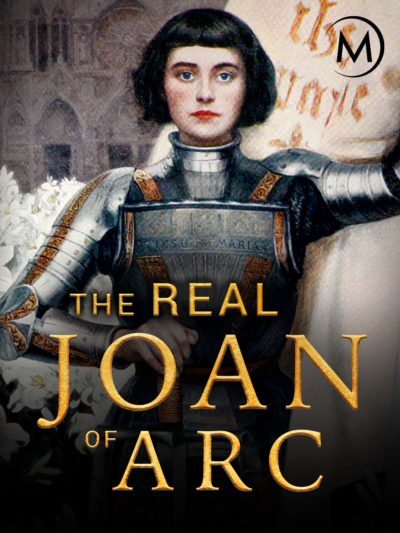★★★
“Live to fight another day?”
 Pun mot intended, but the reality is, we know very little for sure about Joan of Arc. Not even what she looked like in detail, for there are no surviving portraits of her, dating from when she was alive. The facts about her life are equally as uncertain, because everything about Joan was subject to spin, depending on who was talking, when they were saying it, and what agenda they sought to achieve. Because everybody involved had an agenda of one kind or another: either elevating Joan up to the level of literal sainthood (finally achieved in 1920, almost half a millennium after her death), or tearing her down, as a tool of the Devil. Even basic facts – was Joan a shepherd when she was young? – are uncertain, with contradictory testimony.
Pun mot intended, but the reality is, we know very little for sure about Joan of Arc. Not even what she looked like in detail, for there are no surviving portraits of her, dating from when she was alive. The facts about her life are equally as uncertain, because everything about Joan was subject to spin, depending on who was talking, when they were saying it, and what agenda they sought to achieve. Because everybody involved had an agenda of one kind or another: either elevating Joan up to the level of literal sainthood (finally achieved in 1920, almost half a millennium after her death), or tearing her down, as a tool of the Devil. Even basic facts – was Joan a shepherd when she was young? – are uncertain, with contradictory testimony.
It’s really in that light you need to view all this documentary shows. Indeed it largely opens by admitting to the above. This opens the door to questioning the standard narrative, in which Joan is a humble farm-girl, who heard divine voices and was inspired to lead France to fight back against the English invaders. However, I was also left with as much doubt about the alternative suggestions the film provides, because the evidence for them is little if any less sketchy. These theories are certainly interesting – and from a secular viewpoint, elements are perhaps no less plausible than the “voices of God” explanation. On other hand, it feels as if they raise as many questions as they answer.
The first is the suggestion that Joan was actually of noble birth, perhaps an illegitimate child. This could explain things like her reported ability to ride and wield a lance, and speak “proper” French, rather than the coarse dialect of her village. She was, in effect, created for the specific purpose of becoming a figurehead. It’s an intriguing idea – though given events unfolded over a period of several years after she came to public attention, whoever was responsible clearly had to be playing a remarkably long game. It is, though, small beer beside the theory which occupies the second half: Joan was not burned at the stake, but survived, resurfacing a few years later as Jeanne des Armoises, getting married and living a whole second life.
Yeah, big if true. The evidence for this begins with alleged oddities around her death. Joan’s head being covered on her way to the stake; an unusually high pyre; hundreds of English soldiers keeping the locals at bay. Yet there were a lot of people who were present, and subsequently provided, albeit years later, sworn testimony as to her fate. It would have been a remarkable cover-up, to put it mildly. I’m more convinced by the second element: someone, representing herself as Joan, did resurface a few years later, even getting as far as the royal court and meeting Charles VII of France. However, most accounts agree that de Armoises ended up admitting to the fraud, being unable to tell the King information Joan would have known.
I still enjoyed watching this, and the intellectual exercise it provided. It’s always good to keep an open mind about history, and contemplate alternative scenarios, whether they pan out or not. Though some of the recreations leave a little to be desired, this is a decent, well-assembled piece, with good “talking heads”. It did give me pause for thought, and no documentary which does so can be considered a failure.
Dir: Martin Meissonnier
Star: Marcel Gay, Francoise Michaud Frejaville, Colette Beaune, Philippe Contanime
a.k.a. Vraie Jeanne, fausse Jeanne




